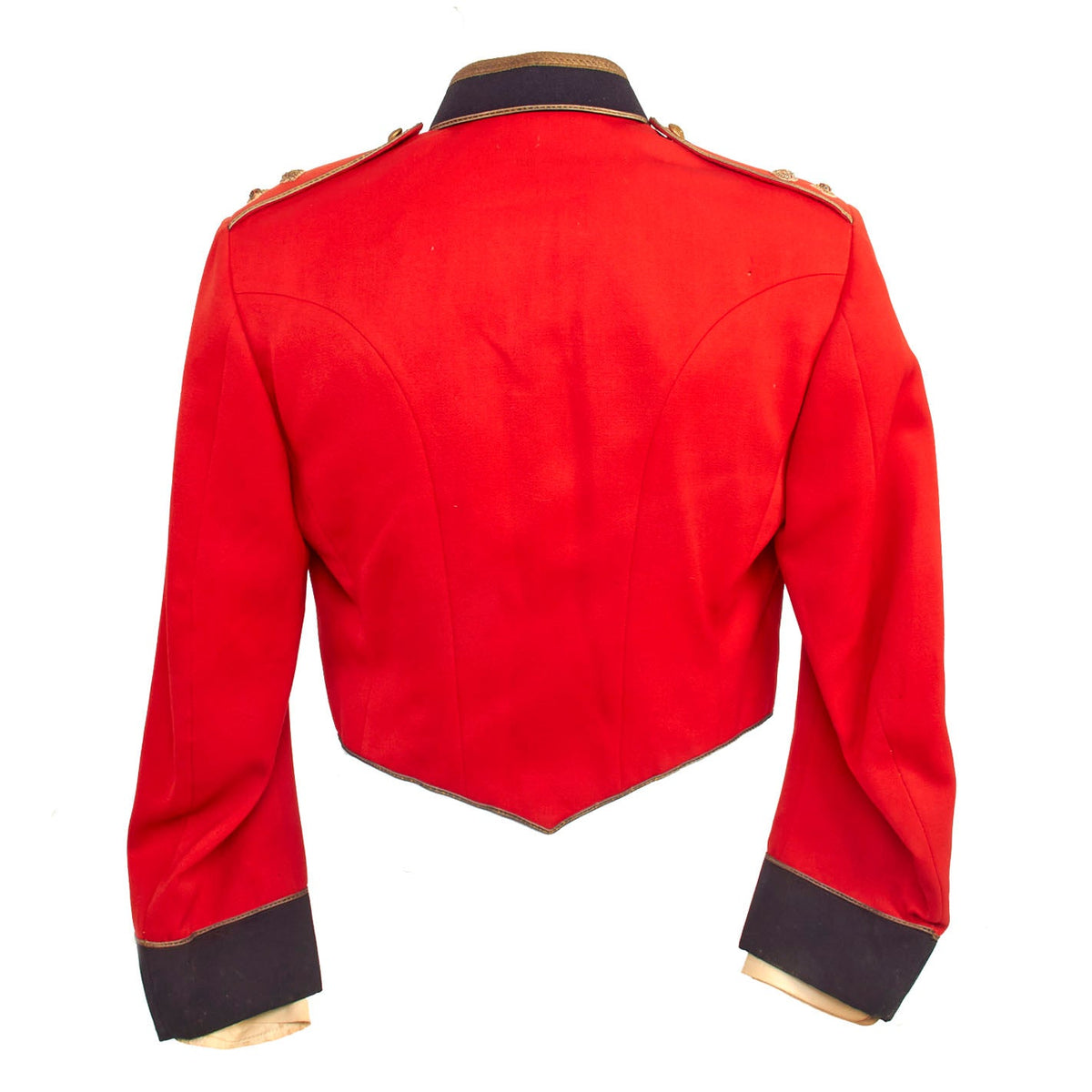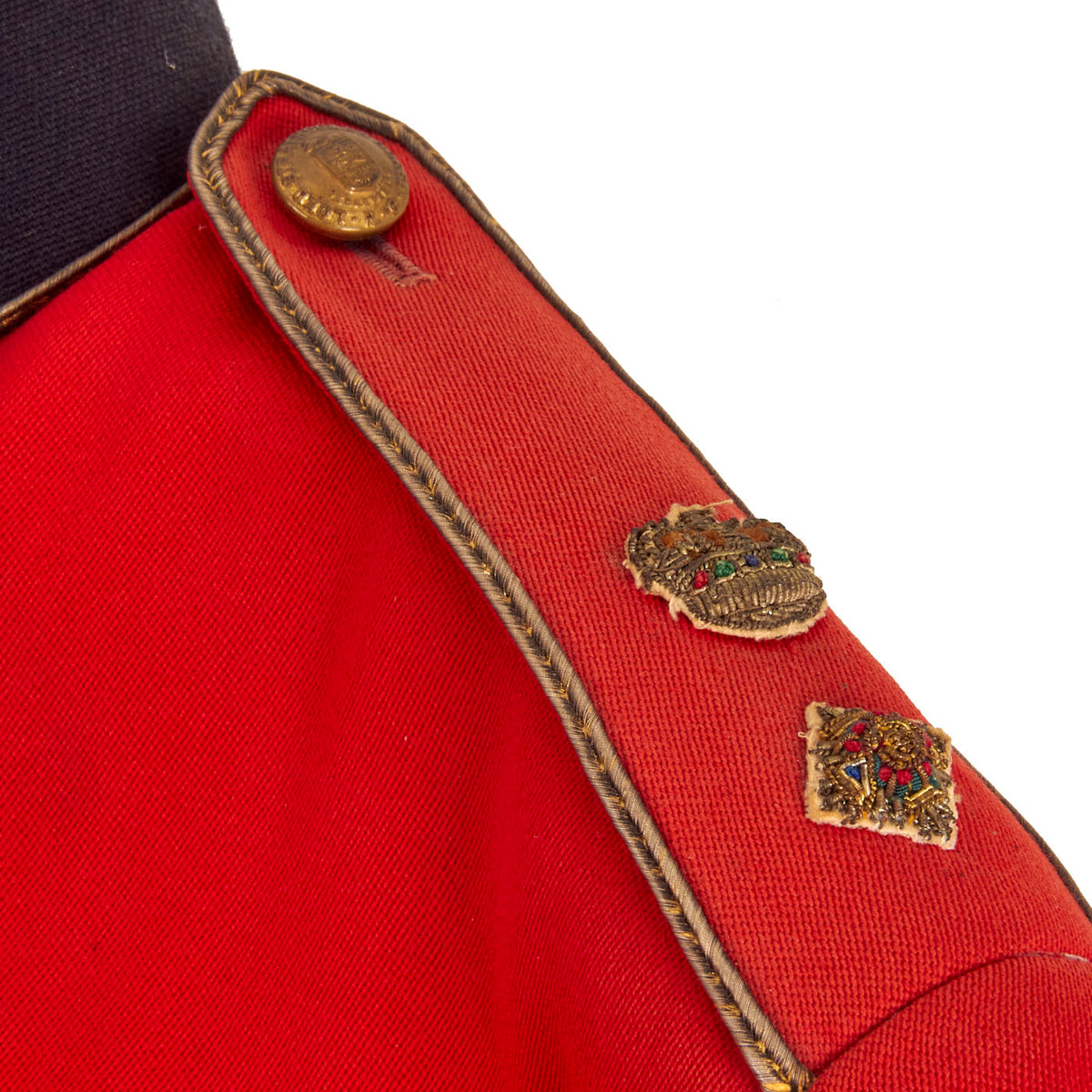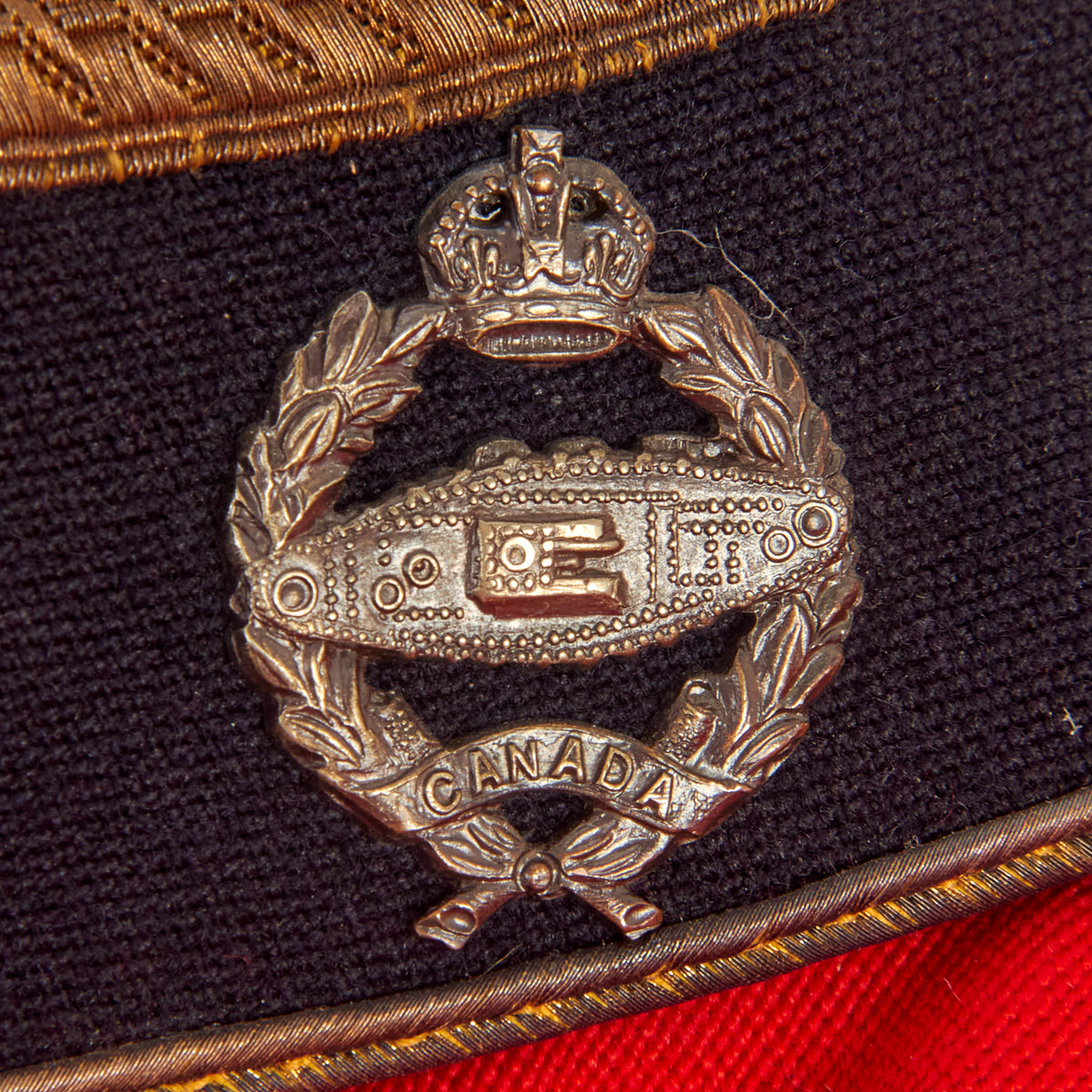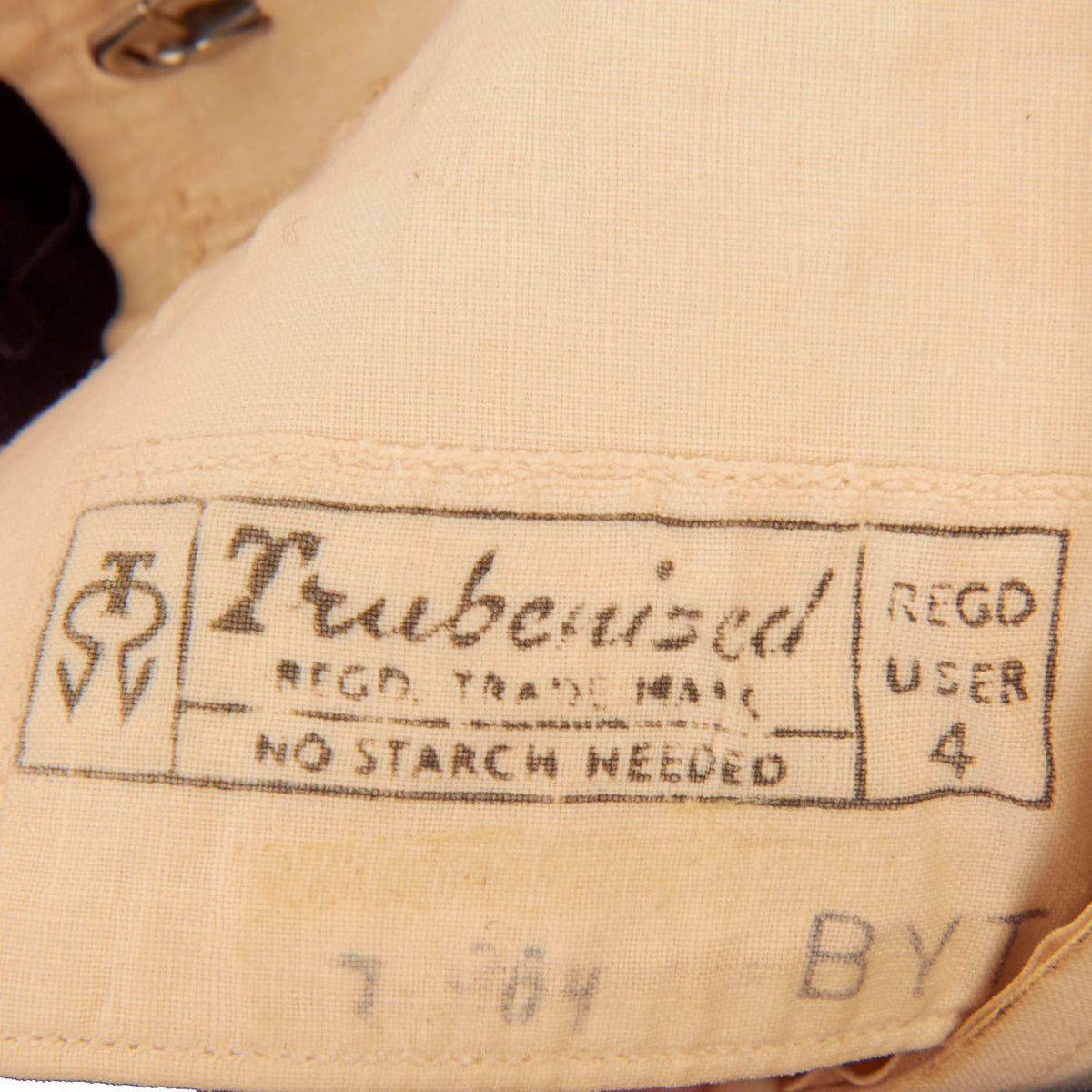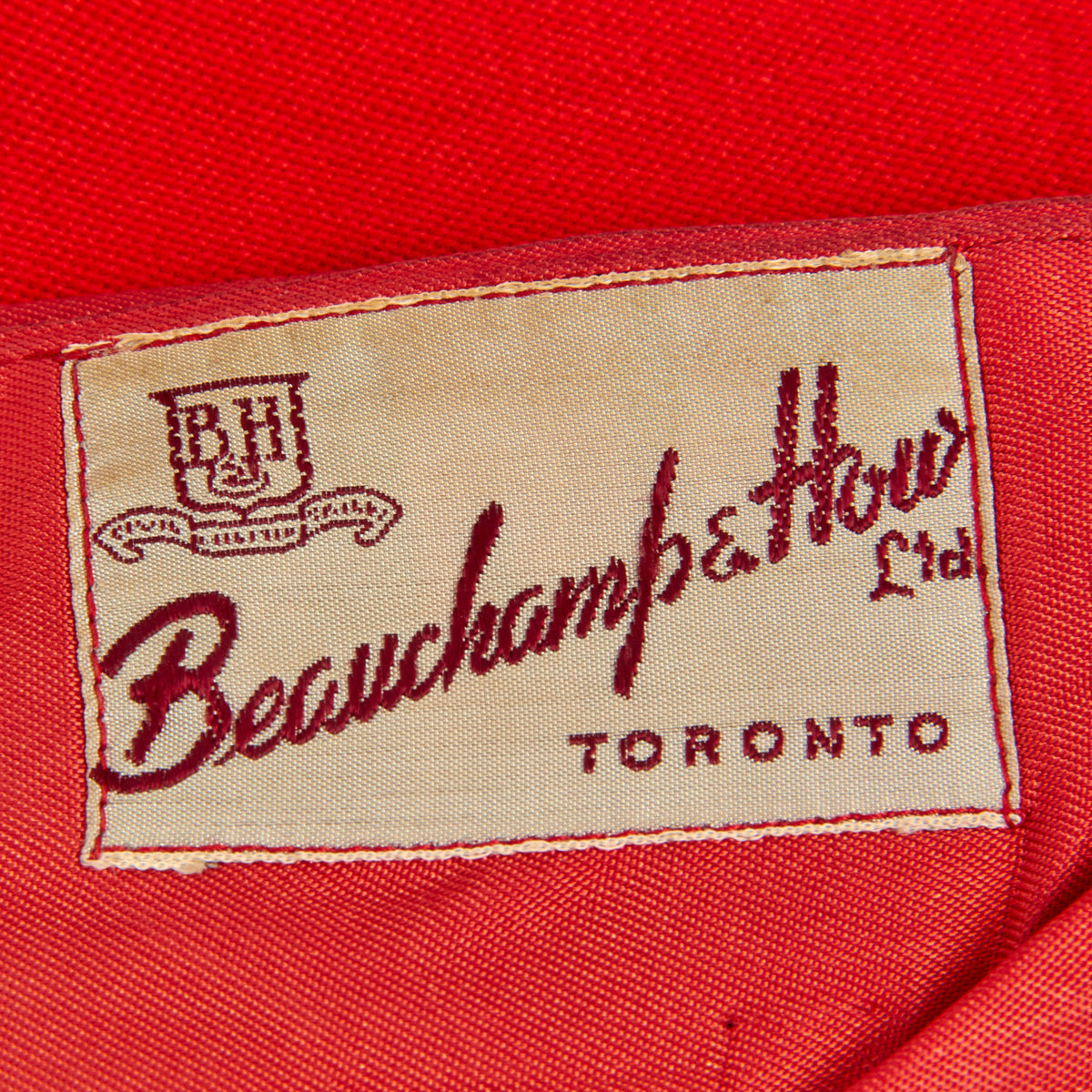Original Canada Korean War Royal Canadian Armored Corps Lieutenant Colonel No. 1 Ceremonial Dress Uniform Tunic Original Items
$ 50,00 $ 30,00
Original Item: Only One Available. The Royal Canadian Armored Corps (RCAC; French: Corps blindé royal canadien) is the armored corps within the Canadian Army, including 3 Regular and 18 Reserve Force regiments as well as the Royal Canadian Armored Corps School.
The corps was formed as the Canadian Armored Corps in 1940, within the Canadian Army (Active). In August 1945, it was given its “royal” designation, and following the Second World War, several Reserve Force units were incorporated into the corps. From 1968 until 2013 it was officially named the Armored Branch.
This jacket once belonged to a Canadian Lieutenant Colonel who served as a unit commander in the Royal Canadian Armored Corps some time before or during the Korean War. This scarlet red uniform is in lovely condition with beautiful bullion rank insignia on the shoulder straps, consisting of a single rank pip below a crown. The jacket is in great condition with minor wear, as this was worn only for ceremonial purposes. The removable white collar and cuffs do show signs of sweat staining but nothing damaging. Each color has a lovely WWII / Inter-War Period Royal Tank Corps insignia with the “Canada” designator positioned at the bottom of the wreath.
The inside left retains a tailor tag for Beauchamp & How Tailors Ltd. in TORONTO. Walter Beauchamp’s is unique among Canadian tailors in that it has been both a civilian and military tailoring business for over 100 years. During WWI, the demand for dress uniforms increased and Beauchamp & How upped their production as part of their civic duty. Eventually they would produce almost all of the Royal Flying Corps uniforms ordered for the RFC stationed in Canada.
This is a lovely example that comes more than ready for further research and display!
Measurements:
Collar to shoulder: 20”
Shoulder to sleeve: 25”
Shoulder to shoulder: 19”
Chest width: 19”
Waist width: N/A”
Hip width: 16”
Front length: 21.5″
Tank Corps History
Originally formed as the Canadian Cavalry Corps in 1910, Canada’s first tank units were not raised until late in 1918. Initially these units were considered to be part of the Machine Gun Corps and the 1st Canadian Tank Battalion, 2nd Canadian Tank Battalion and the 3e Bataillon de chars d’assaut were all too late to join the fighting in the First World War. However, the 1st Canadian Tank Battalion was still training in Mark V tanks in the U.K. when the Canadian Tank Corps was finally authorized two days after the armistice. It seems like tanks were forgotten by the Cavalry after the war. Although, in the 1930s there were some small attempts at mechanization with motorcycles, experimental armored cars and the purchase of a few tracked Carden-Loyd machine gun carriers for training. However, the first tanks since the First World War did not arrive until a few machine gun armed Vickers Mark VI light tanks appeared just one year before Canada went to war with Germany again. From these modest beginnings the modern Canadian Armored Corps began on 13 August 1940 with Major-General (then Colonel) F. F. Worthington as its first colonel-commandant. Over the course of the war from 1939 to 1944, the Armored Corps gradually took over responsibilities from other Corps, such as Tank Regiments all being converted to Armored Regiments, the transition of infantry reconnaissance battalions to the Armored Corps, as well as anti-armour responsibilities from the Artillery Corps. Towards the close of the Second World War, the Corps was subsequently bestowed the honor of the ‘Royal’ designation by King George VI in 1945.
Initially its equipment was 219 US M1917 tanks – a First World War design – obtained at scrap prices. They were sufficient for some training and familiarization, but otherwise of very limited combat use. To form the 1st Army Tank Brigade, Valentine tanks were ordered. This British design was to be built in Canada. Aside from the necessary adjustments to the design to incorporate local engineering standards and available components, the Canadian Valentines used a GMC engine. This engine, being an improvement over the original, was later applied to British production. In practice, Canada never used most of the 1,400 Valentines they built as they were supplied under lend-lease to the Soviet Union.
In early 1941 the 1st Tank Brigade was sent to Britain and equipped with the Matilda infantry tank. For the formation of two armored divisions it was expected that 1,200 cruiser tanks were needed. The United Kingdom was not in a position to supply them, as it had shortfalls in supply for its own needs. This meant that Canada had to develop its own production. To this end a tank arsenal was set up under the management of a subsidiary of a US firm engaged in tank production in order to build the Ram and Grizzly tanks and their variants in Canada.
Events of the Second World War would thrust Canada into large scale tank production with thousands of Valentine, Ram, and Grizzly (Sherman) tanks and their armored variants being produced. Canada would also go on to build modern armored fighting vehicles that served during the Cold War, the War in Afghanistan and global peacekeeping operations.
Canadian armored regiments split their heritage between two primary sources. The first being the cavalry corps, from which many armored regiments were created and in fact the first “armored” regiments were titled “mechanized cavalry” regiments, and the second being the tank corps (which formerly belonged to first the infantry and then the machine gun corps). This began in 1936 with the creation of tank battalions and continued on from 1940 when many other types of regiment were mobilized as armored units for the Second World War.
In 1968, with the unification of the Canadian Army into the Canadian Armed Forces, the name of the Royal Canadian Armored Corps was changed to simply the Armor Branch. Despite the change however, the Corps continued to use its traditional title. In 2003, Canada planned to replace all its tanks with lightweight Mobile Gun Systems. In 2007, due to experience gained during Afghanistan, Leopard tanks were purchased. As of April 2013, the traditional designation of the Royal Canadian Armored Corps has been restored for official use.
Fast Shipping with Professional Packaging
Thanks to our longstanding association with UPS FedEx DHL, and other major international carriers, we are able to provide a range of shipping options. Our warehouse staff is expertly trained and will wrap your products according to our exact and precise specifications. Prior to shipping, your goods will be thoroughly examined and securely secured. We ship to thousands clients each day across multiple countries. This shows how we're dedicated to be the largest retailer on the internet. Warehouses and distribution centres can be located throughout Europe as well as the USA.
Note: Orders with more than one item will be assigned a processing date depending on the item.
Before shipping before shipping, we'll conduct a thorough inspection of the items you have ordered. Today, the majority of orders will be delivered within 48 hours. The delivery time will be between 3-7 days.
Returns
The stock is dynamic and we cannot completely manage it because multiple stakeholders are involved, including our factory and warehouse. So the actual stock may alter at any time. It's possible that you may not receive your order once the order has been made.
Our policy is valid for a period of 30 days. If you don't receive the product within 30 days, we are not able to issue a refund or an exchange.
You can only return an item if it is unused and in the same state as the day you received it. You must have the item in its original packaging.
Related products
Uncategorized
Uncategorized
Uncategorized
Uncategorized
Uncategorized
Uncategorized
Uncategorized
Armoured Fighting Vehicles of the World: AFVs of World War One (Hardcover Book) New Made Items
Uncategorized
Uncategorized
Band of Brothers ORIGINAL GERMAN WWII Le. F.H. 18 10.5cm ARTILLERY PIECE Original Items
Uncategorized
Uncategorized
Uncategorized
Uncategorized
Australian WWII Owen MK1 Machine Carbine SMG Custom Fabricated Replica with Sling Original Items
Uncategorized
Uncategorized
Uncategorized
Armored Burgonet Helmet & Polearm from Scottish Castle Leith Hall Circa 1700 Original Items
Uncategorized
Uncategorized
Uncategorized
Uncategorized

